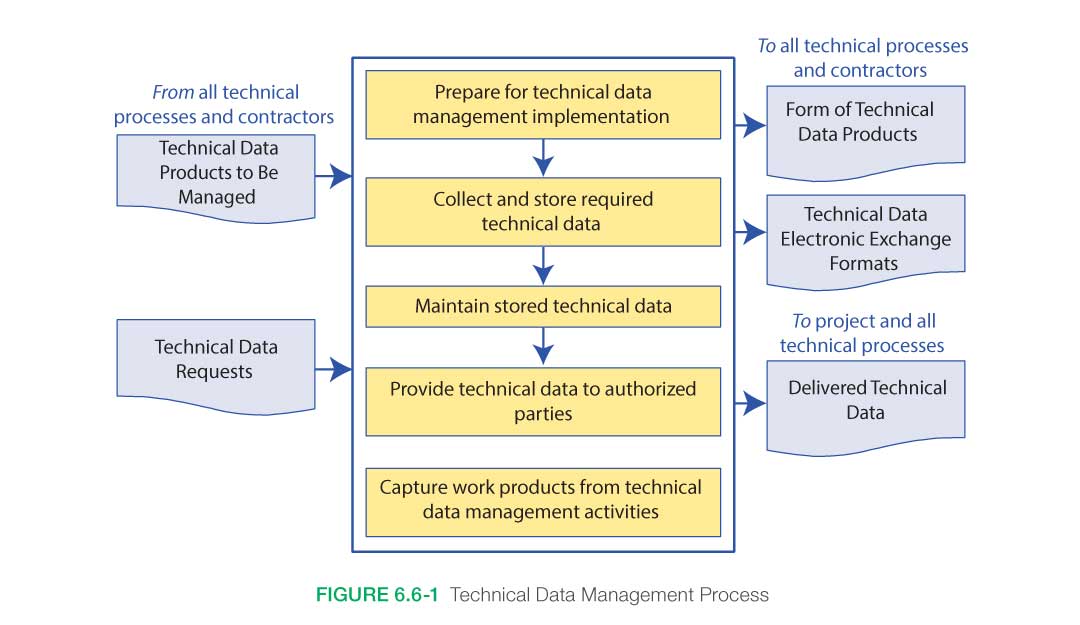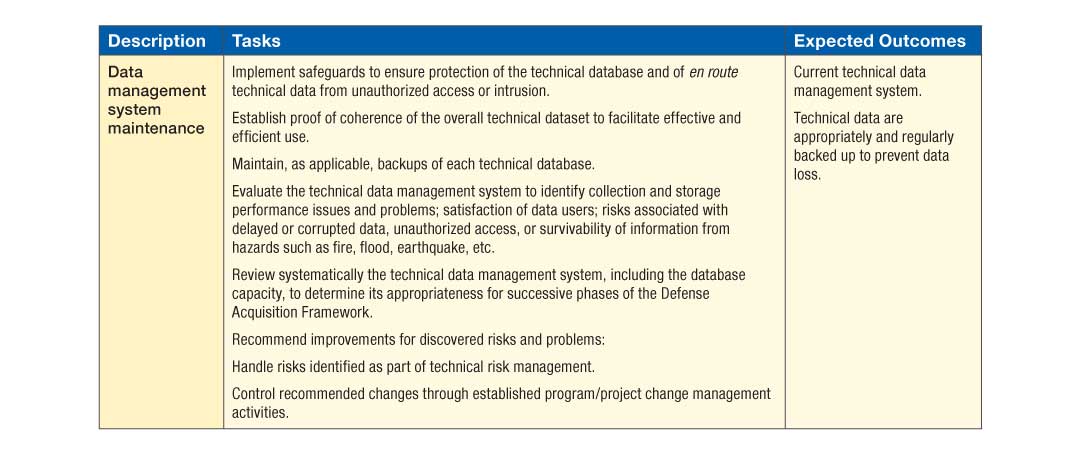6.1 Technical Planning
6.2 Requirements Management
6.3 Interface Management
6.4 Technical Risk Management
6.5 Configuration Management
6.6 Technical Data Management
6.7 Technical Assessment
6.8 Decision Analysis
The Technical Data Management Process is used to plan for, acquire, access, manage, protect, and use data of a technical nature to support the total life cycle of a system. Data Management (DM) includes the development, deployment, operations and support, eventual retirement, and retention of appropriate technical, to include mission and science, data beyond system retirement as required by NPR 1441.1, NASA Records Retention Schedules.
DM is illustrated in Figure 6.6-1. Key aspects of DM for systems engineering include:
- application of policies and procedures for data identification and control,
- timely and economical acquisition of technical data,
- assurance of the adequacy of data and its protection,
- facilitating access to and distribution of the data to the point of use,
- analysis of data use,
- evaluation of data for future value to other programs/projects, and
- process access to information written in legacy software.
The Technical Data Management and Configuration Management Processes work side-by-side to ensure all information about the project is safe, known, and accessible. Changes to information under configuration control require a Change Request (CR) and are typically approved by a Configuration Control Board. Changes to information under Technical Data Management do not need a CR but still need to be managed by identifying who can make changes to each type of technical data.
6.6.1 Process Description
Figure 6.6-1 provides a typical flow diagram for the Technical Data Management Process and identifies typical inputs, outputs, and activities to consider in addressing technical data management.
6.6.1.1 Inputs
The inputs for this process are:
- Technical data products to be managed: Technical data, regardless of the form or method of recording and whether the data are generated by the contractor or Government during the life cycle of the system being developed. (Electronic technical data should be stored with sufficient metadata to enable easy retrieval and sorting.)
- Technical data requests: External or internal requests for any of the technical data generated by the program/project.
6.6.1.2 Process Activities
Each Center is responsible for policies and procedures for technical DM. NPR 7120.5 and NPR 7123.1 define the need to manage data, but leave specifics to the individual Centers. However, NPR 7120.5 does require that DM planning be provided as either a section in the program/project plan, CM plan, or as a separate document. The program or project manager is responsible for ensuring that the data required are captured and stored, data integrity is maintained, and data are disseminated as required.
Other NASA policies address the acquisition and storage of data and not just the technical data used in the life cycle of a system.
6.6.1.2.1 Prepare for Technical Data Management Implementation
The recommended procedure is that the DM plan be a separate plan apart from the program/project plan. DM issues are usually of sufficient magnitude to justify a separate plan. The plan should cover the following major DM topics:
- Identification/definition/management of data sets.
- Control procedures—receipt, modification, review, and approval.
- Guidance on how to access/search for data for users.
- Data exchange formats that promote data reuse and help to ensure that data can be used consistently throughout the system, family of systems, or system of systems.
- Data rights and distribution limitations such as export-control Sensitive But Unclassified (SBU).
- Storage and maintenance of data, including master lists where documents and records are maintained and managed.
Prepare a technical data management strategy. This strategy can document how the program/project data management plan will be implemented by the technical effort or, in the absence of such a program-level plan, be used as the basis for preparing a detailed technical data management plan, including:
- Items of data that will be managed according to program/project or organizational policy, agreements, or legislation;
- The data content and format;
- A framework for data flow within the program/project and to/from contractors including the language(s) to be employed in technical effort information exchanges;
- Technical data management responsibilities and authorities regarding the origin, generation, capture, archiving, security, privacy, and disposal of data products;
- Establishing the rights, obligations, and commitments regarding the retention of, transmission of, and access to data items; and
- Relevant data storage, transformation, transmission, and presentation standards and conventions to be used according to program/project or organizational policy, agreements, or legislative constraints.
- Obtain strategy/plan commitment from relevant stakeholders.
- Prepare procedures for implementing the technical data management strategy for the technical effort and/or for implementing the activities of the technical data management plan.
- Establish a technical database(s) to use for technical data maintenance and storage or work with the program/project staff to arrange use of the program/project database(s) for managing technical data.
- Establish data collection tools, as appropriate to the technical data management scope and available resources.
- Establish electronic data exchange interfaces in accordance with international standards/agreements and applicable NASA standards.
Train appropriate stakeholders and other technical personnel in the established technical data management strategy/plan, procedures, and data collection tools, as applicable
Data Identification/Definition
Each program/project determines data needs during the life cycle. Data types may be defined in standard documents. Center and Agency directives sometimes specify content of documents and are appropriately used for in-house data preparation. The standard description is modified to suit program/project-specific needs, and appropriate language is included in SOWs to implement actions resulting from the data evaluation. “Data suppliers” may be contractors, academia, or the Government. Procurement of data from an outside supplier is a formal procurement action that requires a procurement document; in-house requirements may be handled using a less formal method. Below are the different types of data that might be utilized within a program/project:
- Data
- “Data” is defined in general as “recorded information regardless of the form or method of recording.” However, the terms “data” and “information” are frequently used interchangeably. To be more precise, data generally should be processed in some manner to generate useful, actionable information.
- “Data,” as used in SE DM, includes technical data; computer software documentation; and representation of facts, numbers, or data of any nature that can be communicated, stored, and processed to form information required by a contract or agreement to be delivered to, or accessed by, the Government.
- Data include that associated with system development, modeling and simulation used in development or test, test and evaluation, installation, parts, spares, repairs, usage data required for product sustainability, and source and/or supplier data.
- Data specifically not included in Technical Data Management would be data relating to general NASA workforce operations information, communications information (except where related to a specific requirement), financial transactions, personnel data, transactional data, and other data of a purely business nature.
- Data Call: Solicitation from Government stakeholders (specifically Integrated Product Team (IPT) leads and functional managers) identifies and justifies their data requirements from a proposed contracted procurement. Since data provided by contractors have a cost to the Government, a data call (or an equivalent activity) is a common control mechanism used to ensure that the requested data are truly needed. If approved by the data call, a description of each data item needed is then developed and placed on contract.
- Information: Information is generally considered as processed data. The form of the processed data is dependent on the documentation, report, review formats, or templates that are applicable.
- Technical Data Package: A technical data package is a technical description of an item adequate for supporting an acquisition strategy, production, engineering, and logistics support. The package defines the required design configuration and procedures to ensure adequacy of item performance. It consists of all applicable items such as drawings, associated lists, specifications, standards, performance requirements, quality assurance provisions, and packaging details.
- Technical Data Management System: The strategies, plans, procedures, tools, people, data formats, data exchange rules, databases, and other entities and descriptions required to manage the technical data of a program/project.
6.6.1.2.2 Collect and Store Data
Subsequent activities collect, store, and maintain technical data and provide it to authorized parties as required. Some considerations that impact these activities for implementing Technical Data Management include:
- Requirements relating to the flow/delivery of data to or from a contractor should be specified in the technical data management plan and included in the Request for Proposal (RFP) and contractor agreement.
- NASA should not impose changes on existing contractor data management systems unless the program/project technical data management requirements, including data exchange requirements, cannot otherwise be met.
- Responsibility for data inputs into the technical data management system lies solely with the originator or generator of the data.
- The availability/access of technical data lies with the author, originator, or generator of the data in conjunction with the manager of the technical data management system.
- The established availability/access description and list should be baselined and placed under configuration control.
- For new programs/projects, a digital generation and delivery medium is desired. Existing programs/projects should weigh the cost/benefit trades of digitizing hard copy data.
Table 6.6-1 defines the tasks required to capture technical data.

6.6.1.2.3 Provide Data to Authorized Parties
All data deliverables should include distribution statements and procedures to protect all data that contain critical technology information, as well as to ensure that limited distribution data, intellectual property data, or proprietary data are properly handled during systems engineering activities. This injunction applies whether the data are hard copy or digital.
As part of overall asset protection planning, NASA has established special procedures for the protection of Critical Program Information (CPI). CPI may include components; engineering, design, or manufacturing processes; technologies; system capabilities, and vulnerabilities; and any other information that gives a system its distinctive operational capability.
CPI protection should be a key consideration for the technical data management effort and is part of the asset protection planning process.
Data Collection Checklist
- Have the frequency of collection and the points in the technical and technical management processes when data inputs will be available been determined?
- Has the timeline that is required to move data from the point of origin to storage repositories or stakeholders been established?
- Who is responsible for the input of the data?
- Who is responsible for data storage, retrieval, and security?
- Have necessary supporting tools been developed or acquired?
6.6.1.3 Outputs
Outputs include timely, secure availability of needed data in various representations to those authorized to receive it. Major outputs from the Technical Data Management Process include the following (see Figure 6.6-1):
- Form of Technical Data Products: How each type of data is held and stored such as textual, graphic, video, etc.
- Technical Data Electronic Exchange Formats: Description and perhaps templates, models or other ways to capture the formats used for the various data exchanges.
- Delivered Technical Data: The data that were delivered to the requester.
Other work products generated as part of this process include the strategy and procedures used for technical data management, request dispositions, decisions, and assumptions.
6.6.2 Technical Data Management Guidance
Refer to Section 6.6.2 in the NASA Expanded Guidance for Systems Engineering at https://nen.nasa.gov/web/se/doc-repository for additional guidance on:
- data security and
- ITAR.





























